wheelbase FIAT DUCATO 2006 Owner handbook (in English)
[x] Cancel search | Manufacturer: FIAT, Model Year: 2006, Model line: DUCATO, Model: FIAT DUCATO 2006Pages: 238, PDF Size: 3.29 MB
Page 83 of 238
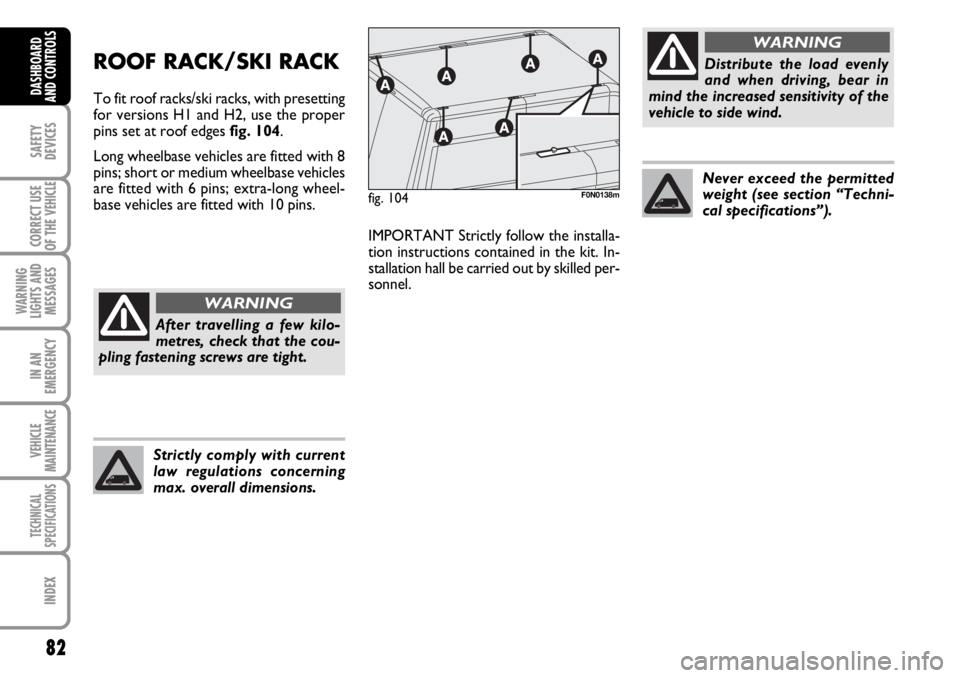
Distribute the load evenly
and when driving, bear in
mind the increased sensitivity of the
vehicle to side wind.
82
SAFETY
DEVICES
CORRECT USE
OF THE
VEHICLE
WARNING
LIGHTS AND
MESSAGES
IN AN
EMERGENCY
VEHICLE
MAINTENANCE
TECHNICAL
SPECIFICATIONS
INDEX
DASHBOARD
AND CONTROLS
ROOF RACK/SKI RACK
To fit roof racks/ski racks, with presetting
for versions H1 and H2, use the proper
pins set at roof edges fig. 104.
Long wheelbase vehicles are fitted with 8
pins; short or medium wheelbase vehicles
are fitted with 6 pins; extra-long wheel-
base vehicles are fitted with 10 pins.
After travelling a few kilo-
metres, check that the cou-
pling fastening screws are tight.
WARNING
Strictly comply with current
law regulations concerning
max. overall dimensions.
Never exceed the permitted
weight (see section “Techni-
cal specifications”).
IMPORTANT Strictly follow the installa-
tion instructions contained in the kit. In-
stallation hall be carried out by skilled per-
sonnel.
fig. 104F0N0138m
WARNING
Page 144 of 238
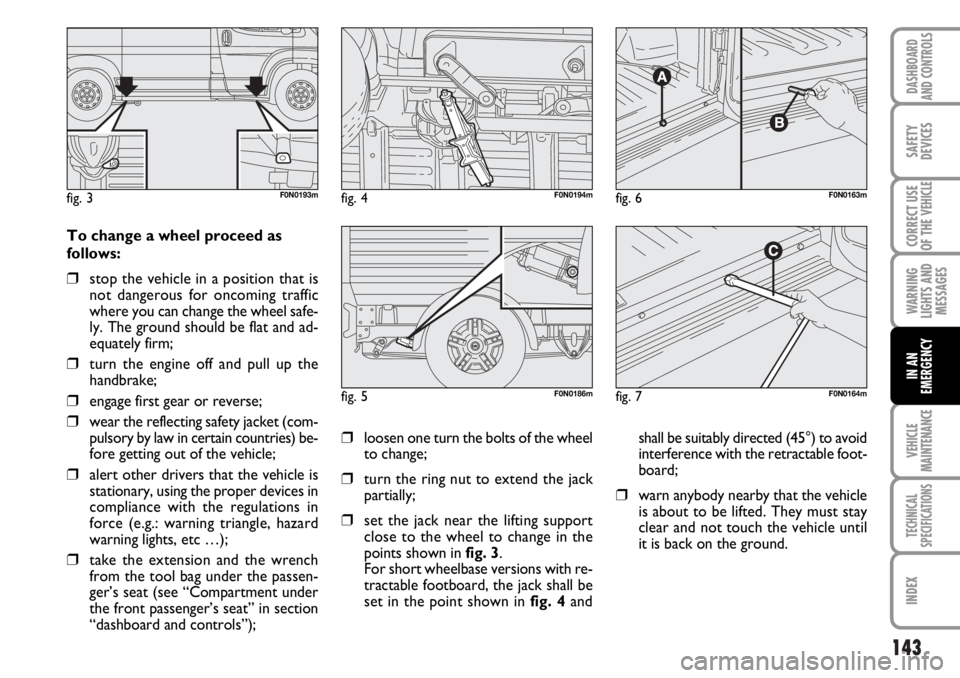
143
WARNING
LIGHTS AND
MESSAGES
VEHICLE
MAINTENANCE
TECHNICAL
SPECIFICATIONS
INDEX
DASHBOARD
AND CONTROLS
SAFETY
DEVICES
CORRECT USE
OF THE
VEHICLE
IN AN
EMERGENCY
To change a wheel proceed as
follows:
❒stop the vehicle in a position that is
not dangerous for oncoming traffic
where you can change the wheel safe-
ly. The ground should be flat and ad-
equately firm;
❒turn the engine off and pull up the
handbrake;
❒engage first gear or reverse;
❒wear the reflecting safety jacket (com-
pulsory by law in certain countries) be-
fore getting out of the vehicle;
❒alert other drivers that the vehicle is
stationary, using the proper devices in
compliance with the regulations in
force (e.g.: warning triangle, hazard
warning lights, etc …);
❒take the extension and the wrench
from the tool bag under the passen-
ger’s seat (see “Compartment under
the front passenger’s seat” in section
“dashboard and controls”);
❒loosen one turn the bolts of the wheel
to change;
❒turn the ring nut to extend the jack
partially;
❒set the jack near the lifting support
close to the wheel to change in the
points shown in fig. 3.
For short wheelbase versions with re-
tractable footboard, the jack shall be
set in the point shown in fig. 4andshall be suitably directed (45°) to avoid
interference with the retractable foot-
board;
❒warn anybody nearby that the vehicle
is about to be lifted. They must stay
clear and not touch the vehicle until
it is back on the ground.
fig. 3F0N0193mfig. 4F0N0194m
fig. 5F0N0186m
fig. 6F0N0163m
fig. 7F0N0164m
Page 197 of 238
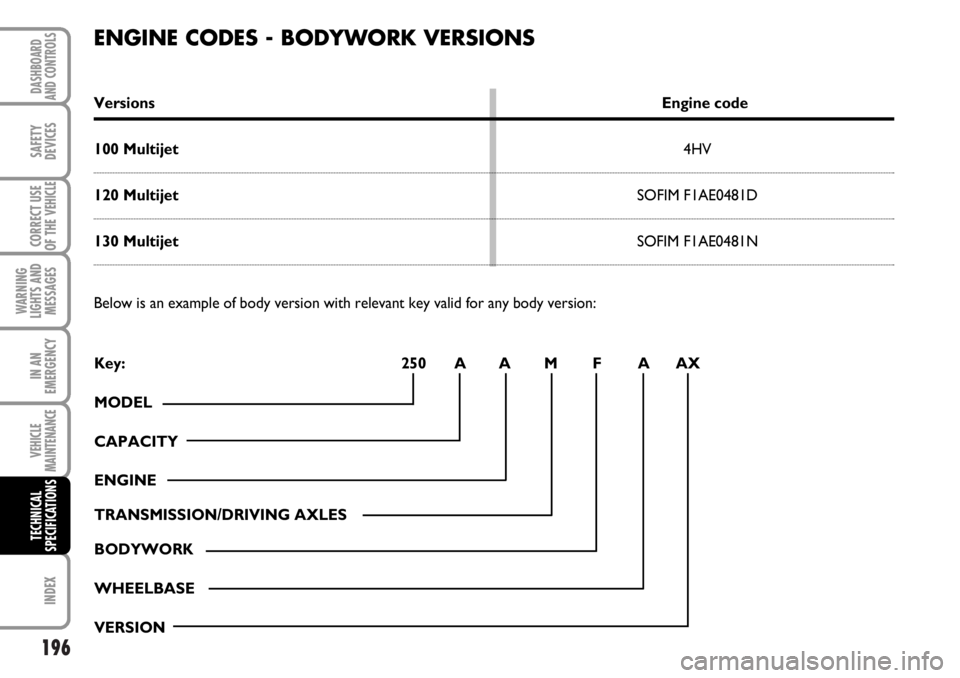
196
WARNING
LIGHTS AND
MESSAGES
INDEX
DASHBOARD
AND CONTROLS
SAFETY
DEVICES
CORRECT USE
OF THE
VEHICLE
IN AN
EMERGENCY
VEHICLE
MAINTENANCE
TECHNICAL
SPECIFICATIONS
ENGINE CODES - BODYWORK VERSIONS
VersionsEngine code
100 Multijet4HV
120 MultijetSOFIM F1AE0481D
130 MultijetSOFIM F1AE0481N
Below is an example of body version with relevant key valid for any body version:
Key: 250 A A M F A AX
MODEL
CAPACITY
ENGINE
TRANSMISSION/DRIVING AXLES
BODYWORK
WHEELBASE
VERSION
Page 198 of 238

197
WARNING
LIGHTS AND
MESSAGES
INDEX
DASHBOARD
AND CONTROLS
SAFETY
DEVICES
CORRECT USE
OF THE
VEHICLE
IN AN
EMERGENCY
VEHICLE
MAINTENANCE
TECHNICAL
SPECIFICATIONS
CAPACITY
A3,000 kg
B3,300 kg
C3,500 kg LIGHT
D3,500 kg HEAVY
E4,005 kg
ENGINES
A100 Multijet
C120 Multijet
E130 Multijet
TRANSMISSION
MMechanical gearbox
AAutomatic gearbox
BODYWORK
AChassis-cab chassisGLong cab body
BChassis without cabHLong cab chassis
CChassis-cab floorMMinibus
DBodyPPanorama
ESchoolbus for primary schoolRMixed 6/9 seats
LSchoolbus for secondary schoolUChassis without cab “Floor”
FVan
WHEELBASE
AShort wheelbase
BMedium wheelbase
CLong wheelbase
DMedium long wheelbase
Page 201 of 238
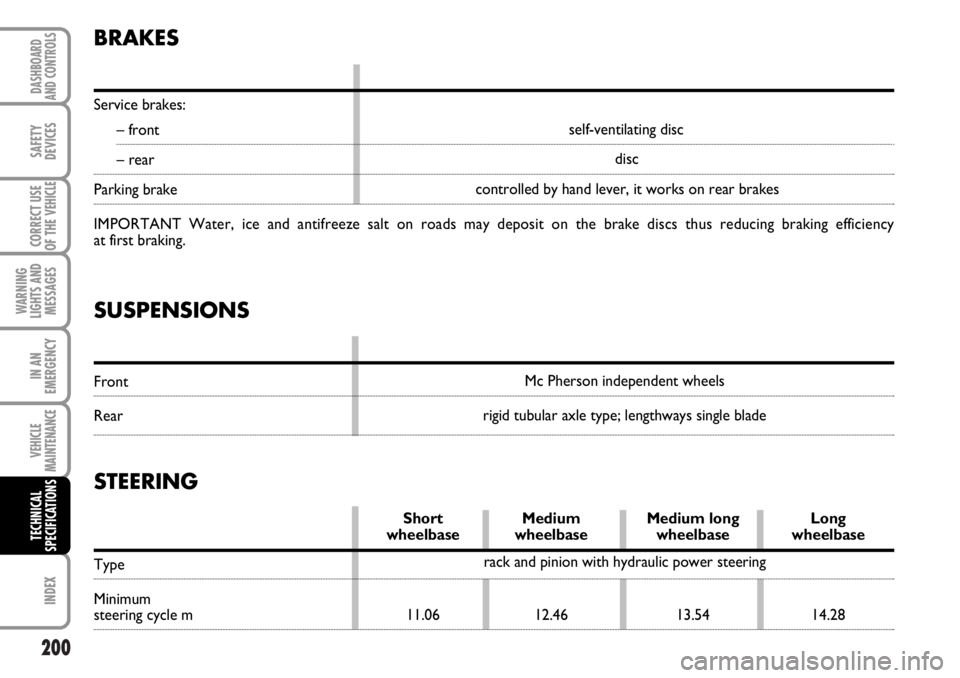
200
WARNING
LIGHTS AND
MESSAGES
INDEX
DASHBOARD
AND CONTROLS
SAFETY
DEVICES
CORRECT USE
OF THE
VEHICLE
IN AN
EMERGENCY
VEHICLE
MAINTENANCE
TECHNICAL
SPECIFICATIONS
SUSPENSIONS
Front
Rear
BRAKES
Service brakes:
– front
– rear
Parking brake
IMPORTANT Water, ice and antifreeze salt on roads may deposit on the brake discs thus reducing braking efficiency
at first braking.
Mc Pherson independent wheels
rigid tubular axle type; lengthways single blade controlled by hand lever, it works on rear brakesdisc self-ventilating disc
rack and pinion with hydraulic power steering
STEERING
Short Medium Medium long Long wheelbase wheelbase wheelbase wheelbase
Type
Minimum
steering cycle m 11.06 12.46 13.54 14.28
Page 213 of 238
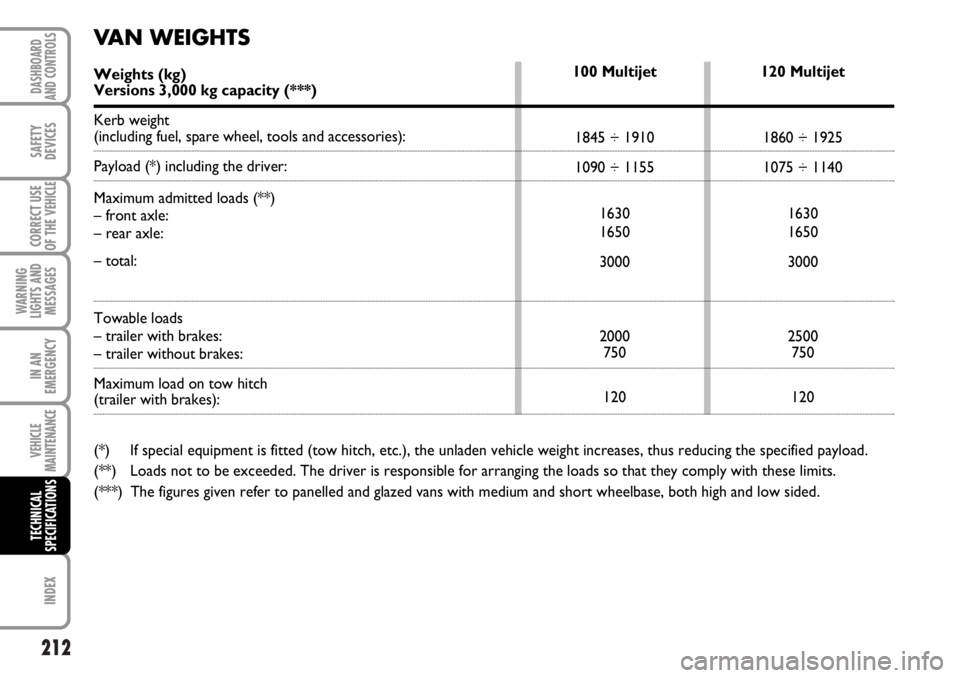
212
WARNING
LIGHTS AND
MESSAGES
INDEX
DASHBOARD
AND CONTROLS
SAFETY
DEVICES
CORRECT USE
OF THE
VEHICLE
IN AN
EMERGENCY
VEHICLE
MAINTENANCE
TECHNICAL
SPECIFICATIONS
120 Multijet
1860 ÷ 1925
1075 ÷ 1140
1630
1650
3000
2500
750
120 100 Multijet
1845 ÷ 1910
1090 ÷ 1155
1630
1650
3000
2000
750
120
VAN WEIGHTS
Weights (kg)Versions 3,000 kg capacity (***)
Kerb weight
(including fuel, spare wheel, tools and accessories):
Payload (*) including the driver:
Maximum admitted loads (**)
– front axle:
– rear axle:
– total:
Towable loads
– trailer with brakes:
– trailer without brakes:
Maximum load on tow hitch
(trailer with brakes):
(*) If special equipment is fitted (tow hitch, etc.), the unladen vehicle weight increases, thus reducing the specified payload.
(**) Loads not to be exceeded. The driver is responsible for arranging the loads so that they comply with these limits.
(***) The figures given refer to panelled and glazed vans with medium and short wheelbase, both high and low sided.
Page 214 of 238

213
WARNING
LIGHTS AND
MESSAGES
INDEX
DASHBOARD
AND CONTROLS
SAFETY
DEVICES
CORRECT USE
OF THE
VEHICLE
IN AN
EMERGENCY
VEHICLE
MAINTENANCE
TECHNICAL
SPECIFICATIONS
120 Multijet
1860 ÷ 2000
1300 ÷ 1440
1750
1900
3300
2500
750
120 100 Multijet
1845 ÷ 1985
1315 ÷ 1455
1750
1900
3300
2000
750
120
VAN WEIGHTS
Weights (kg)Versions 3,300 kg capacity (***)
Kerb weight
(including fuel, spare wheel, tools and accessories):
Payload (*) including the driver:
Maximum admitted loads (**)
– front axle:
– rear axle:
– total:
Towable loads
– trailer with brakes:
– trailer without brakes:
Maximum load on tow hitch
(trailer with brakes):
(*) If special equipment is fitted (tow hitch, etc.), the unladen vehicle weight increases, thus reducing the specified payload.
(**) Loads not to be exceeded. The driver is responsible for arranging the loads so that they comply with these limits.
(***) The figures given refer to panelled and glazed vans with medium and short wheelbase, both high and low sided.
Page 215 of 238
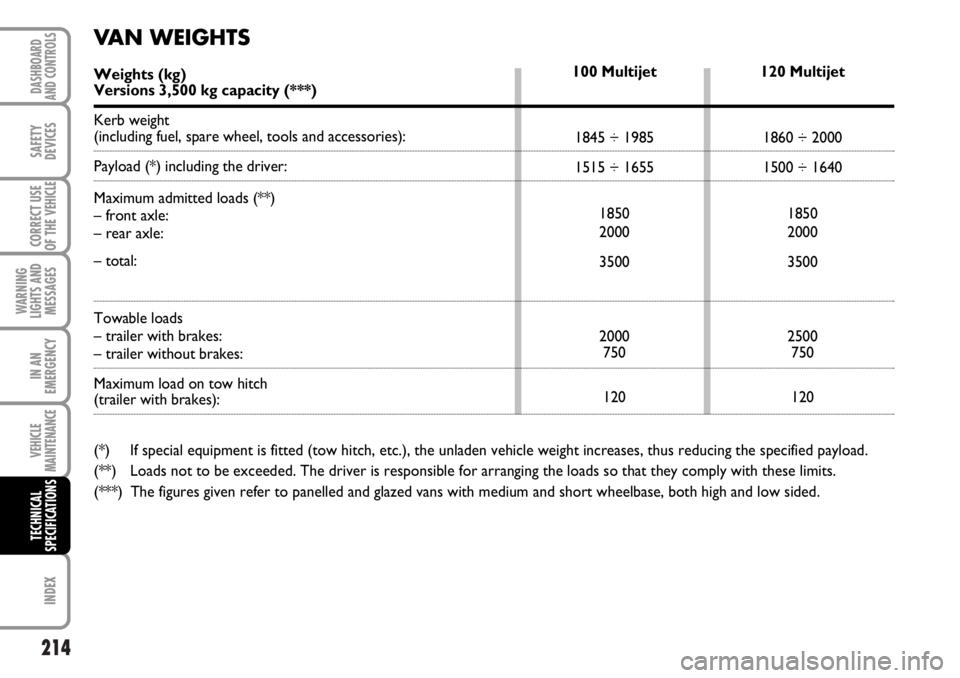
214
WARNING
LIGHTS AND
MESSAGES
INDEX
DASHBOARD
AND CONTROLS
SAFETY
DEVICES
CORRECT USE
OF THE
VEHICLE
IN AN
EMERGENCY
VEHICLE
MAINTENANCE
TECHNICAL
SPECIFICATIONS
120 Multijet
1860 ÷ 2000
1500 ÷ 1640
1850
2000
3500
2500
750
120 100 Multijet
1845 ÷ 1985
1515 ÷ 1655
1850
2000
3500
2000
750
120
VAN WEIGHTS
Weights (kg)Versions 3,500 kg capacity (***)
Kerb weight
(including fuel, spare wheel, tools and accessories):
Payload (*) including the driver:
Maximum admitted loads (**)
– front axle:
– rear axle:
– total:
Towable loads
– trailer with brakes:
– trailer without brakes:
Maximum load on tow hitch
(trailer with brakes):
(*) If special equipment is fitted (tow hitch, etc.), the unladen vehicle weight increases, thus reducing the specified payload.
(**) Loads not to be exceeded. The driver is responsible for arranging the loads so that they comply with these limits.
(***) The figures given refer to panelled and glazed vans with medium and short wheelbase, both high and low sided.